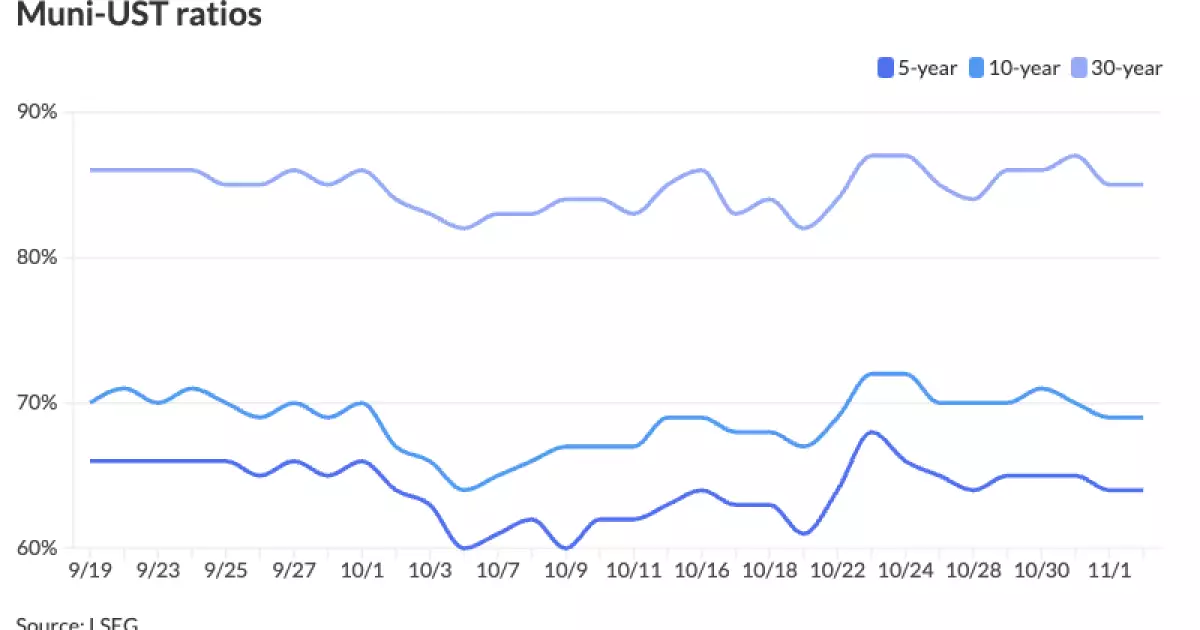As we approach a pivotal election and the critical Federal Open Market Committee (FOMC) meeting, the municipal securities market is witnessing notable shifts. Investors are acutely aware of the potential for volatility arising from these concurrent events. The previous trading day observed a firm uptick in municipal bonds, while U.S. Treasury yields declined, particularly in longer maturities. This interaction between the bond market and political dynamics sets the stage for a transformative period in municipal investment.
According to Refinitiv Municipal Market Data, municipal to U.S. Treasury (UST) yield ratios have been a focal point for investors. As of the latest readings, the two-year ratio settled at a modest 63%, while longer durations like the 30-year reached 85%. ICE Data Services echoed similar findings with slightly varying percentages, reflecting a stable but cautious approach to investing amidst uncertainty. The ratios hint at a delicate balance of supply and demand, influenced significantly by broader economic forecasts and political outcomes.
Investor Sentiment and Anticipated Market Movements
Investor sentiment is a crucial indicator in the current market climate. Daryl Clements, a municipal portfolio manager at AllianceBernstein, emphasizes the need for investors to brace for potential volatility. The election outcomes could radically alter the political and economic landscape, igniting fluctuations in yields and inflation expectations. For instance, a ‘red wave’ could lead to a swift increase in both, while a ‘blue wave’ might stabilize pressures through tax adjustments.
Tom Kozlik of HilltopSecurities contends that a divided government might present the most favorable scenario. It could create a stasis in legislative progress, allowing yields to stabilize and inflation expectations to remain in check. Regardless, the consensus among financial strategists is that yields will likely trend lower over time, creating opportunities for astute investors.
The FOMC Meeting: Implications for Monetary Policy
In tandem with electoral uncertainty, the upcoming FOMC meeting looms large on the horizon. The Federal Reserve’s decisions regarding interest rates are expected to be informed by recent economic data. A 50-basis-point rate cut was implemented in September, but opinions diverge on whether a further cut is warranted or if a pause is more likely. Kozlik pointed out that the labor market’s recent performance has reignited concerns, with job growth lagging significantly behind forecasts. Investors will be closely watching how the Fed navigates these challenges, as their stances can either exacerbate or mitigate market volatility.
Despite the anticipated turbulence, municipal markets have shown signs of resilience with a return to more balanced activity. There were reports of strong two-way flows, indicating a renewed interest among accounts that had previously been hesitant. Birch Creek strategists noted a marked increase in trading volume, particularly for maturities ranging from ten years and beyond.
Investors are not just hesitant observers; they are actively seeking to capitalize on favorable yield levels, prompting a significant uptick in purchase activity. The inflow of $659 million into municipal mutual funds last week—marking an impressive 18 consecutive weeks of positive inflows—underscores a robust appetite for municipal bonds. Such momentum suggests that while uncertainty looms, the fundamentals of demand continue to support municipal market performance.
Looking ahead, the primary market is poised for a quieter week as issuances taper following heightened activity in previous weeks. Pat Luby from CreditSights forecasts a significant kinks in new issues, with a potential drop in issuance to between $20 billion and $25 billion for November, a stark comparison to over $56 billion in October. Even so, a noteworthy issuance from the Texas Municipal Gas Acquisition and Supply Corporation has surfaced, offering investors new opportunities amidst a scarcity of fresh supply.
The anticipated net supply for the months ahead indicates a depletion of bonds available for purchase, placing an emphasis on the technical picture favoring investors in terms of yields and demand. Clements noted that a landscape characterized by strong demand coupled with dwindling supply could lead to healthy performance for municipal securities in the near future, further suggesting that yields are expected to decline.
As we navigate this complex interplay of market dynamics shaped by electoral events and impending monetary policy decisions, the municipal securities market stands at a crossroads. Investors must remain alert and agile, ready to adapt to shifting winds wrought by political changes and economic signals. The anticipation of lower yields over time presents various opportunities, inviting participants to engage thoughtfully in this evolving landscape. The coming days will undoubtedly bring new insights as the outcomes of these crucial events unfold.

